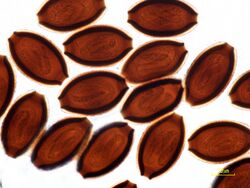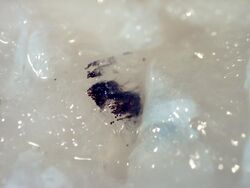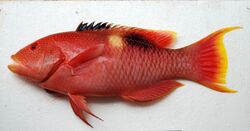Biology:Huffmanela
| Huffmanela | |
|---|---|

| |
| Eggs of Huffmanela hamo | |
| Scientific classification | |
| Domain: | Eukaryota |
| Kingdom: | Animalia |
| Phylum: | Nematoda |
| Class: | Enoplea |
| Order: | Trichocephalida |
| Family: | Trichosomoididae |
| Subfamily: | Huffmanelinae |
| Genus: | Huffmanela Moravec, 1987[1] |
Huffmanela is a genus of parasitic nematodes, belonging to the family Trichosomoididae.
Morphology
As other nematodes, species of Huffmanela are elongate and vermiform. They are especially thin and small. The male is smaller than the female. The stichosome is composed of a single row of stichocytes (glandular cells). The advances eggs contain larvae and have strongly pigmented, dark, often conspicuously thick walls comprising three layers,[2] and polar plugs.[3]
The structure of the egg of Huffmanela nematodes has been redescribed in great detail in 2023, with a new anatomical and terminological framework.[4]
Biology
Nematodes of the genus Huffmanela are all parasites of fishes.[1] They infect various tissues (skin, mucosa, musculature, swimbladder wall, intestine wall, and even within the bones)[5] of elasmobranchs (sharks) and bony fishes. The life cycle of the marine species is not known.[3]
Females lay eggs in the host's tissues at a very early stage and eggs continue to develop after being laid.
Eggs usually occur as masses in the tissues of the hosts, occurring frequently as conspicuous black spots in the flesh or other organs of fish; these black spots may constitute a commercial problem.[3]
[6][7]
[8]
Life cycle
The life cycle of Huffmanela huffmani, the only species from freshwater, has been elucidated in 2016; it includes amphipods as intermediate hosts.[9] The diagrams shows the steps in the life cycle of Huffmanela huffmani.
- A – adults lay eggs in definitive host; at least 7.5 months must pass between ingestion of viable larva and the appearance of fertilised eggs in the host swim bladder, but eggs do not become fully larvated and infective to amphipods until 11.5 months post infection (p.i.): 1 – centrarchid definitive host; 2 – photomicrograph of swim bladder tissue showing eggs in various stages of development;
- B – release of eggs from definitive host: 3 – definitive host dies and decomposes to release eggs; 4 – definitive host is consumed by piscivorous fish and viable eggs with sufficiently developed shells pass out in faeces;
- C – eggs free in sediments: 5a – young eggs (<10 months p.i.) with inadequately developed shells will not survive in environment or passage through piscivore gastrointestinal (GI) tract; 5b – unlarvated eggs old enough to have fully developed egg shells (>10 months p.i.) can survive in environment and through GI tract of piscivore, but are uninfective to amphipods until they become fully larvated while in sediments; 5c – fully larvated eggs (≥11.5 months p.i.) are immediately infective to amphipods and are still infective to amphipods after 36+ months in sediments;
- D – fully larvated eggs ingested by amphipod: 6 – larvae hatch and migrate to hemocoel where they must remain for at least 5 days p.i. before being infective to definitive host; 7 – larva in hemocoel of amphipod and infective to centrarchid. Life cycle can be completed in a theoretical minimum of 12 months, but can probably take longer than 36 months.
The life cycle of marine species is still unknown.
Systematics
In zoology, new species are generally described only from adult specimens; however, in the case of Huffmanela species, it happens that the eggs are often the only stage which is known. For this reason, several species of Huffmanela have been described from eggs only.[3][5] This is exceptional but perfectly valid for the International Code of Zoological Nomenclature, and eggs are considered syntypes of the new species.[5]
Classification
According to Moravec(2001),[3] Huffmanela is the single genus within the subfamily Huffmanelinae Moravec, 2001.
The type-species of the genus Huffmanela is Huffmanela carcharini (McCallum, 1925) Moravec, 1987,[1] a species originally described as Capillaria carcharhini MacCallum, 1925
and Capillaria spinosa MacCallum, 1926 by MacCallum.
Twenty species of Huffmanela have been described with a binomial name (or Latin name) [7] [10] [11] [12] [13] [14] [15] [16] [17] [18] [19] [20]
Of these 20 species, only 5 have their adult forms known and described (Table below); all others have been described from eggs only. Hosts include a variety of fish species and families (Table below), generally marine, with a single exception, H. huffmani in a freshwater fish host. [21]
In addition to these described species, about half a dozen cases of Huffmanela spp., or unnamed species, have been reported in various fish hosts. [22] [23] [24] [25] [26] [27]
Described species of Huffmanela, description of their adult form, and host fish species and family
| Species | Adult | Hosts |
|---|---|---|
| Huffmanela balista Justine, 2007 [10] | described | Abalistes stellatus (Balistidae) |
| Huffmanela banningi Moravec, 1987 [1] | unknown | Cynoglossus browni (Cynoglossidae) |
| Huffmanela branchialis Justine, 2004 [5] | unknown | Nemipterus furcosus (Nemipteridae) |
| Huffmanela canadensis Moravec, Conboy & Speare, 2005 [12] | described | Sebastes spp. (Sebastidae) |
| Huffmanela carcharini (MacCallum, 1925) Moravec, 1987 [1] | unknown | Carcharhinus melanopterus, C. plumbeus (Carcharhinidae) |
| Huffmanela filamentosa Justine, 2004 [5] | unknown | Gymnocranius grandoculis (Lethrinidae) |
| Huffmanela hamo Justine & Iwaki, 2014[7] | unknown | Muraenesox cinereus (Muraenesocidae) |
| Huffmanela huffmani Moravec, 1987 | described [21] | Lepomis spp., Amblopites rupestris, Micropterus salmoides (Centrarchidae) |
| Huffmanela japonica Moravecet al., 1998 [13] | unknown | Upeneus japonicus (Mullidae) |
| Huffmanela lata Justine, 2005 [14] | unknown | Carcharhinus amblyrhynchos (Carcharhinidae) |
| Huffmanela longa Justine, 2007 [10] | described | Gymnocranius oblongus, Gymnocranius grandoculis (Lethrinidae) |
| Huffmanela markgracei Ruiz & Bullard, 2013 [20] | unknown | Rhizoprionodon terraenovae (Carcharhinidae) |
| Huffmanela mexicana Moravec & Fajer-Avila, 2000 [15] | unknown | Sphoeroides annulatus (Tetraodontidae) |
| Huffmanela moraveci Carballo & Navone, 2007 [16] | described | Odontesthes smitti, O. nigricans (Atherinopsidae) |
| Huffmanela oleumimica Ruiz et al., 2012 [19] | unknown | Lutjanus campechanus (Lutjanidae) |
| Huffmanela ossicola Justine, 2004 [5] | unknown | Bodianus loxozonus, B. perditio , B. busellatus (Labridae) |
| Huffmanela paronai Moravec & Garibaldi, 2000 [17] | unknown | Xiphias gladius (Xiphiidae) |
| Huffmanela plectropomi Justine, 2011 [11] | unknown | Plectropomus leopardus (Serranidae) |
| Huffmanela schouteni Moravec & Campbell, 1991 [18] | unknown | Hirundichthys affinis, Cheilopogon cyanopterus, C. heterurus (Exocoetidae) |
| Huffmanela shikokuensis Moravec et al., 1998 [13] | unknown | Stephanolepis cirrhifer (Monacanthidae) |
Medical interest
All known species of Huffmanela are strictly parasite of fishes, and none can infest humans. However, cases of spurious parasitism have been described in the medical literature from coprological studies.[23] Since infestation of fish are often heavy, with millions of eggs in a single fish,[10] it is understandable that consumption of such an infested fish, even well cooked, can results in numerous eggs in human feces. Because of their polar plugs, eggs of nematodes of the genera Anatrichosoma, Capillaria or Trichuris can sometimes induce misidentifications.[28]
References
- ↑ 1.0 1.1 1.2 1.3 1.4 Moravec, František. 1987: Revision of Capillariid Nematodes (Subfamily Capillariinae) parasitic in fishes. Studie ČSAV No. 3, Academia, Praha, 141 pp.
- ↑ Žd'árská, Z.; Huffman, D. G.; Moravec, F.; Nebesářová, J. (2001). "Egg shell ultrastructure of the fish nematode Huffmanela huffmani (Trichosomoididae)". Folia Parasitologica 48: 231–234.
- ↑ 3.0 3.1 3.2 3.3 3.4 Moravec, František. 2001: Trichinelloid Nematodes parasitic in cold-blooded vertebrates. Academia, Praha (ISBN:80-200-0805-5)
- ↑ Bond, Alan Thomas; Huffman, David George (2023). "Nematode eggshells: A new anatomical and terminological framework, with a critical review of relevant literature and suggested guidelines for the interpretation and reporting of eggshell imagery". Parasite 30: 6. doi:10.1051/parasite/2023007.

- ↑ 5.0 5.1 5.2 5.3 5.4 5.5 Justine, Jean-Lou (2004). "Three new species of Huffmanela Moravec, 1987 (Nematoda: Trichosomoididae) from the gills of marine fish off New Caledonia". Systematic Parasitology 59 (1): 29–37. doi:10.1023/B:SYPA.0000038442.25230.8b. ISSN 0165-5752. PMID 15318018.
- ↑ Conboy, G. A.; Speare, D. J. (2002). "Dermal nematodosis in commercially captured rockfish (Sebastes spp.) from coastal British Columbia, Canada". Journal of Comparative Pathology 127: 211–213. doi:10.1053/jcpa.2002.0567.
- ↑ 7.0 7.1 7.2 Justine, J.-L.; Iwaki, T. (2014). "Huffmanela hamo sp. n. (Nematoda: Trichosomoididae: Huffmanelinae) from the dagger-tooth pike conger Muraenesox cinereus off Japan". Folia Parasitologica 61: 267–271. doi:10.14411/fp.2014.029. http://folia.paru.cas.cz/pdfs/fol/2014/03/11.pdf.
- ↑ Ana Raquel Almeida Carvalho, 2014. Contribuição para o conhecimento de nematodes Huffmanela spp. como causa de rejeição em lota da faneca (Trisopterus luscus).Dissertações de Mestrado. Universidade de Trás-os-Montes e Alto Douro. Abstract and PDF

- ↑ Worsham, McLean L. D.; Huffman, David G.; Moravec, Frantisek; Gibson, J. Randy (2016). "The life cycle of Huffmanela huffmani Moravec, 1987(Nematoda: Trichosomoididae), an endemic marine-relict parasite of Centrarchidae from a Central Texas spring". Folia Parasitologica 63. doi:10.14411/fp.2016.020. ISSN 0015-5683. http://folia.paru.cas.cz/artkey/fol-201601-0020_The_life_cycle_of_Huffmanela_huffmani_Moravec_1987_Nematoda_Trichosomoididae_an_endemic_marine-relict_paras.php.

- ↑ 10.0 10.1 10.2 10.3 Justine, Jean-Lou (2007). "Huffmanela spp. (Nematoda, Trichosomoididae) parasites in coral reef fishes off New Caledonia, with descriptions of H. balista n. sp. and H. longa n. sp." (PDF). Zootaxa 1628: 23–41. doi:10.11646/zootaxa.1628.1.2. http://www.mapress.com/zootaxa/2007/zt01628p041.pdf.
- ↑ 11.0 11.1 Justine, Jean-Lou (2011). "Huffmanela plectropomi n. sp. (Nematoda: Trichosomoididae: Huffmanelinae) from the coralgrouper Plectropomus leopardus (Lacépède) off New Caledonia". Systematic Parasitology 79: 139–143. doi:10.1007/s11230-011-9296-9.
- ↑ 12.0 12.1 Moravec, F. E.; Conboy, G. A.; Speare, D. J. (2005). "A new trichosomoidid from the skin of Sebastes spp. (Pisces) from British Columbia, Canada". Journal of Parasitology 91: 411–414. doi:10.1645/ge-3420.
- ↑ 13.0 13.1 13.2 Moravec, F.; Koudela, B.; Ogawa, K.; Nagasawa, K. (1998). "Two new Huffmanela species, H. japonica n. sp. and H. shikokuensis n. sp (Nematoda: Trichosomoididae), from marine fishes in Japan". Journal of Parasitology 84: 589–593. doi:10.2307/3284728.
- ↑ 14.0 14.1 Justine, J.-L. (2005). "Huffmanela lata n. sp. (Nematoda: Trichosomoididae: Huffmanelinae) from the shark Carcharhinus amblyrhynchos (Elasmobranchii: Carcharhinidae) off New Caledonia". Systematic Parasitology 61 (3): 181–184. doi:10.1007/s11230-005-3160-8. PMID 16025207.
- ↑ 15.0 15.1 Moravec, F.; Fajer-Avila, E. (2000). "Huffmanela mexicana n. sp (Nematoda: Trichosomoididae) from the marine fish Sphoeroides annulatus in Mexico". Journal of Parasitology 86: 1229–1231. doi:10.1645/0022-3395(2000)086[1229:hmnsnt2.0.co;2].
- ↑ 16.0 16.1 Carballo, M. C.; Navone, G. T. (2007). "A new Huffmanela species (Nematoda: Trichosomoididae) parasitizing atherinid fishes in North Patagonian Gulfs, Argentina". Journal of Parasitology 93: 377–382. doi:10.1645/ge-971r.1.
- ↑ 17.0 17.1 Moravec, F.; Garibaldi, F. (2000). "Huffmanela paronai sp. n. (Nematoda: Trichosomoididae), a new parasite from the skin of swordfish Xiphias gladius in the Ligurian Sea (Western Mediterranean)". Folia Parasitologica 47: 309–313. doi:10.14411/fp.2000.053.
- ↑ 18.0 18.1 Moravec, F.; Campbell, B. G. (1991). "A new Huffmanela species, H. schouteni sp. n. (Nematoda, Trichosomoididae) from flying fishes in Curaçao". Folia Parasitologica 38: 29–32.
- ↑ 19.0 19.1 Ruiz, C. F.; Ray, C. L.; Cook, M.; Grace, M. A.; Bullard, S. A. (2012). "A new species of Trichosomoididae (Nematoda) from skin of red snapper, Lutjanus campechanus (Perciformes: Lutjanidae), on the Texas-Louisiana shelf, Northern Gulf of Mexico". Journal of Parasitology 99: 318–326. doi:10.1645/GE-3249.1.
- ↑ 20.0 20.1 Ruiz, C. F.; Bullard, S. A. (2013). "Huffmanela markgracei sp. n. (Nematoda: Trichosomoididae) from buccal cavity of Atlantic sharpnose shark, Rhizoprionodon terraenovae (Carcharhiniformes: Carcharhinidae), in the northwestern Gulf of Mexico off Texas". Folia Parasitologica 60: 353–358. doi:10.14411/fp.2013.036.
- ↑ 21.0 21.1 Huffman, D. G.; Moravec, F. (1988). "First description of adult Huffmanela huffmani Moravec, 1987 (Nematoda: Trichosomoididae) from the swimbladder of centrachid fishes of the upper San Marcos River, central Texas". Folia Parasitologica 35: 227–234.
- ↑ Esteves, A.; Seixas, F.; Carvalho, S.; Nazario, N.; Mendes, M.; Martins, C. (2009). "Huffmanela sp (Nematoda: Trichosomoididae) muscular parasite from Trisopterus luscus captured off the Portuguese coast". Diseases of Aquatic Organisms 84: 251–255. doi:10.3354/dao02048.
- ↑ 23.0 23.1 Gállego, J.; Riera, C.; Portús, M. (1993). "Huffmanela sp. eggs (Nematoda: Trichosomoididae), as a human spurious parasite in a child from Barcelona (Spain)". Folia Parasitologica 40: 208–210. http://folia.paru.cas.cz/pdfs/showpdf.php?pdf=21092.
- ↑ MacLean, R. A.; Fatzinger, M. H.; Woolard, K. D.; Harms, C. A. (2006). "Clearance of a dermal Huffmanela sp in a sandbar shark (Carcharhinus plumbeus) using levamisole". Diseases of Aquatic Organisms 73: 83–88. doi:10.3354/dao073083.
- ↑ Mendes, M., Madeira de Carvalho, L. M., Ramos, P., Fazendeiro, I. & Afonso-Roque, M. M. (2005). Presence of Huffmanela eggs (Nematoda: Trichosomoididae), in the faneca muscle - Trisopterus luscus (Linnaeus, 1758) of the coast of Portugal. Paper presented at the IX Congresso Ibérico de Parasitologia, 25–28 October 2005, Coimbra, Portugal.
- ↑ Bullard, S. A.; Ruiz, C. F.; McElwain, A.; Murray, M. J.; Borucinska, J. D.; Benz, G. W. (2012). "Huffmanela cf. carcharhini (Nematoda: Trichosomoididae: Huffmanelinae) from skin of a sandbar shark, Carcharhinus plumbeus, in the Pacific Ocean". Journal of Parasitology 98: 333–340. doi:10.1645/GE-2962.1.
- ↑ Dill, Jennifer A.; Field, Cara L.; Camus, Alvin C. (2016). "Pathology in Practice". Journal of the American Veterinary Medical Association 249 (3): 275–277. doi:10.2460/javma.249.3.275. ISSN 0003-1488.
- ↑ Núñez, F.A. (2010). "Trichuris, Capillaria or Anitrichosoma [sic]?". Parasitology International 59: 303. doi:10.1016/j.parint.2010.02.008.
External links
Wikidata ☰ Q5929592 entry
 |




